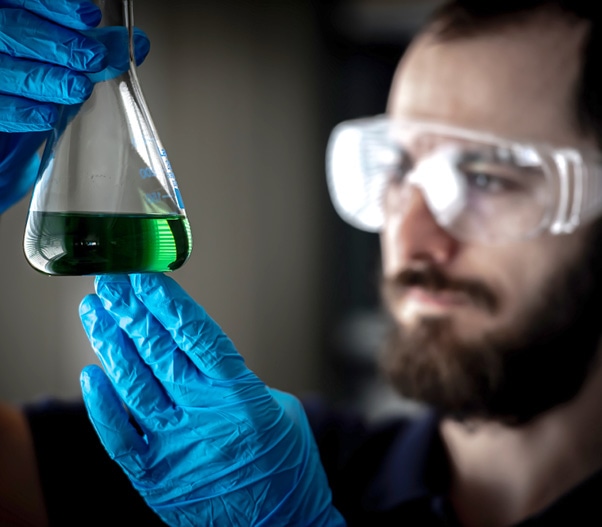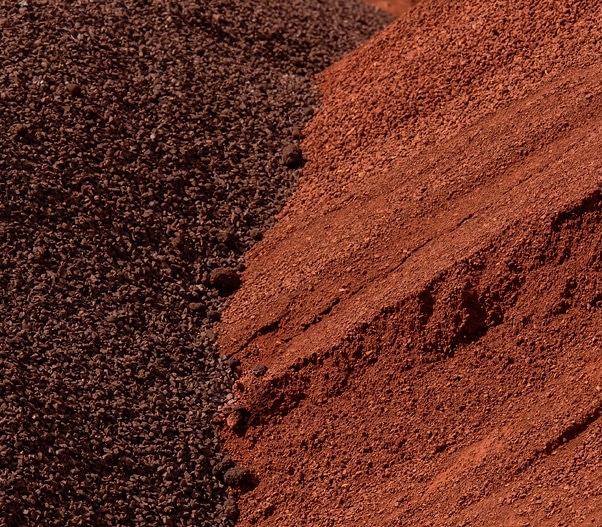Other significant Environmental topics
Raw & other materials
Regarding the use of primary natural resources in the production of the main products of MYTILINEOS, the quantity of bauxite used in the Metallurgy Business Unit to produce aluminium and alumina in 2021 was slightly increased compared to 2020 (4.5%), while the total quantity of natural gas used in the Power & Gas Business Unit decreased by 10.9%. The Sustainable Engineering Solutions (SES) and Renewables & Storage Development (RSD) Business Units do not manage primary natural resources, but instead use semi-ready or finished products.
In detail:
In the Metallurgy Business Unit, approximately 2.6 million tons of raw materials were used in 2021, to produce alumina and primary and secondary aluminium products, a quantity increased compared to 2020. Of this total quantity, 74% was bauxite, while the remaining 26% regarded the use of other raw materials from non-renewable sources.
MYTILINEOS, in its effort to limit the consumption of natural resources and to reduce the energy required in aluminium production, has adopted in its production process the practice of recasting aluminium waste (scrap) that replaces the use of raw materials. Furthermore, in this direction, the Company has also expanded its activities in the industrial production, processing and trading of metals and in particular of aluminium alloys and their products, investing in the know-how for the optimal treatment of aluminium scrap, so as to be able, in the years to come, to produce raw materials again, spending a much lower quantity of energy and thus significantly cutting costs and mitigating the impact on the environment.
The Sustainable Engineering Solutions (SES) and Renewables & Storage Development (RSD) Business Units do not manage primary natural resources, but instead use semi-finished or finished products, according to the detailed plans and procedures for each project, which specify with great accuracy each material to be used, its manufacturing method and its exact position and operation. Additionally, a key criterion in the design stage of the projects that the Business Unit is carrying out is the use of recyclable materials. The Company's requests for proposals and contracts with suppliers of materials and equipment contain a specific clause regarding their compliance with the requirements of the ISO 14001 standard, specifically referring to the prohibition of using environmentally hazardous materials and the obligation to make the maximum possible use of recyclable materials.
In the Power & Gas Business Unit, the raw material used in power plants is natural gas, which is the transition fuel towards an economy with lower greenhouse gas emissions. The annual consumption of natural gas in the Company's thermal units is linked to the fluctuations in the generation of electricity on an annual basis, and in 2021 recorded a slight decrease by 10.9% compared to 2020, due mainly to the scheduled maintenance of power plant of Korinthos Power. Regarding the materials used in the production process and not incorporated in the end product, such as lubricating oils and chemicals, in 2021 these remained close to their 2020 levels.
| 2019 | 2020 | 2021 | Basic materials | |
|---|---|---|---|---|
| Metallurgy Business Unit ASI | ||||
| Raw materials | 2,265,428 | 2,278,815 | 2,373,121 | Bauxite, Alumina, Aluminium Scrap |
| Materials (not incorporated in the end product) | 237,655 | 250,133 | 264,995 | Anodes, Lime, Soda, Coke, Tar |
| Packaging materials | 1,309 | 1,192 | 1,125 | Pine planks, Rings |
| Total | 2,504,392 | 2,530,140 | 2,638,928 | |
| Recycled materials | 39,922 | 49,012 | 50,181 | Aluminium scrap |
| Percentage of recycled input materials | 1.59% | 1.94% | 1.90% | |
| Composite Construction and Steel Treatment Units | ||||
| Materials (used in the production process but not incorporated in the end product) | 256.0 | 309.9 | 313.3 | Oxygen, Argon, Nitrogen |
| Semi-finished products | 649.3 | 1,043.2 | 1,301.1 | Steel |
| Packaging materials | 4.5 | 8.2 | 8.1 | Nylon |
| Total | 909.8 | 1,361.3 | 1,622.5 | |
| Recycled materials | 235.2 | 372.6 | 440.8 | Recycled steel |
| Percentage of recycled input materials | 25.8% | 27.4% | | |
Research & Development
Research & Development is not just another business choice but a modern-day necessity in the context of the Sustainable Development Goals (SDGs). To this end, MYTILINEOS invests in research and development with the aim of contributing, acknowledging its share of the relevant responsibility, to strengthening scientific research, upgrading the technological capabilities of the country's industrial sector, and encouraging innovation, thus ensuring industrial diversification and the added value of its products and services.
In the Metallurgy Business Unit, the Company continues to consistently invest in the installation of pilot units for the development of research in the following areas:
- Utilization of bauxite residues: The Company both participates in and conducts pilot tests in the framework of European programs on the use of efficient "green" technologies in the production of useful products and materials (iron, alumina, cement additives and construction products), as well as on the development of technologies for the extraction of rare earths.
- New aluminium recycling technologies: The Company participates in research programs on the design and control of the production of recycled aluminium products with a low energy and environmental footprint.
At the same time, the Company continues to consistently invest in research for the development of know-how in new technologies, and is actively participating in research activities in the following fields:
- Utilization of carbon-rich by-products of the alumina electrolysis production process, exploring a recycling technology within the aluminium production cycle.
- Heat recovery and utilization from exhaust gas flows of the aluminium production process.
- Use of RES in alumina / aluminium production: The Company participates in a Study Network exploring the possibilities of direct application of RES in the industry.
- Digitization alumina and aluminium production processes.
- Education and lifelong learning: The Company participates in programs aimed at developing new tools and training courses for engineers and technicians working in the raw materials and metallurgy sector.
In this direction, the Research and Sustainable Development activity was established under the Innovation Division of the Company's Metallurgy Business Unit. The Company participates in 24 research projects co-funded by the EU or the Greek State under the Horizon 2020, EIT Raw Materials, EIT Manufacturing, ERA-NET Cofund on Raw Materials (ERA-MIN 2) programs, and under programs of the Greek General Secretariat for Research and Technology (GSRT). MYTILINEOS participates in these programs with a view to increasing competitiveness and exploring the application of an industrial circular economy.
The total financing of the programs for the period 2017-2025, exceeds €120 million, of which €8.7 million are related to investments of the Metallurgy Business Unit of MYTILINEOS, while the applied research is carried out in collaboration with industrial partners, research bodies and universities in Greece and Europe.
In summary, in 2021, the Unit’s Research and Sustainable Development activity announced the following research results on a pilot scale, while the two pilot units continued to operate for testing new metallurgical processes at the aluminium plant:
-

Production of 1st scandium concentrate from bauxiteresidues.
Under the SCALE project
(scale-project.eu), 10 m3 of bauxite residue extract solution were treated using the SIR technology of the company II-VI. The treatment resulted in the production of 200 g of solid concentrate containing 34% by weight of scandium oxide. The overall process has succeeded in upgrading the scandium concentration from the bauxite residues to the concentrate by 3000 times(youtu.be/qFE8nrcRDHY). The technology will be further optimized in the SCALE-Up program which starts in 2022 and will be co-funded under the EIT Raw Materials program.Scandium is a metal, classified as a rare earth element, whose global production does not exceed 15 tons (mainly from industrial by-products) and is used in "emerging" technological applications such as: (a) "Electrolytic" gas-fired power generation (SOFC), whose efficiency is twice that of conventional thermal power plants, (b) very high resistance Aluminium-Scandium alloys, such as the Al-Sc-Mg alloy used by AIRBUS in 3D component printing technology
(scale-project.eu). ASI -

Recovery of soda from bauxiteresidues.
Under the RemovAl program
(removal-project.com), 600 kg of bauxite residues underwent hydrometallurgical treatment in order for their soda content to be recovered. The new "dealkalized" bauxite residues contain less than 0.5% by weight soda and will be tested as a raw material for the production of mixing cement under the ReActiv program. Today, bauxite residues are used to a limited extent as a raw material for the production of the cement raw meal ("farin"). Their conversion into an "active ingredient" (the so-called supplementary cementious material) is the main objective of the ReActiv programreactivproject.eu) coordinated by the company Holcim in collaboration with MYTILINEOS. -

Recovery of alumina from bauxite residueslag.
Under the RemovAl program, 300 kg of bauxite slag, which had been produced by the Research and Sustainable Development Department activity in 2020, underwent hydrometallurgical treatment in order for their alumina content to be recovered. 70% of the alumina was extracted in the solution and then precipitated using CO2 gas, producing about 40 kg of hydrated alumina as the final product.
-

Treatment of Greek bauxite using the Pedersenmethod.
Under the ENSUREAL programme
(ensureal.com), 2 tons of Greek bauxite (from MYTILINEOS’ subsidiary DELPHI-DISTOMON) underwent pyrometallurgical treatment for obtaining a cast iron product, while the slag produced underwent hydrometallurgical treatment for producing hydrated alumina. This process is an alternative to the Bayer method for the treatment of bauxites, which leads to fewer and more easily usable by-products.
The above technologies are intended for use in developing the know-how of the Metallurgy Business Unit for the production of new products, investigating technical solutions to sustainability problems, and exploring the possible future activity of MYTILINEOS in new markets if and when these are considered profitable.
In addition, DELPHI-DISTOMON launched a pilot project on the digital monitoring of ventilation at an underground work site. The solution used (Ventilation-on-Demand) had been designed to ensure air quality in underground mining sites and reduce the energy consumption of the ventilation system. It combines cutting-edge technologies such as Internet of Things, Cloud big data, Sensors.
In the Power & Gas Business Unit, an Applied Research & Development and Innovation Department is in operation. In 2021, more than 10 projects were underway in this Department, including the following:
- Energy Blockchain — Green PPAs: Green Power Purchase Agreements (PPAs), which constitute a contract between the two parties and certify the provider of "green" energy, the amount of energy, the value of the energy, the geographical information of the place of origin of the agreed energy, etc.
- Digital Innovations: New mobile apps, marketplaces and innovative digital processes to upgrade the digital customer engagement and on-boarding of Retail customers (Protergia ON).
- AI Factory: creation of processes, know-how and organization of an internal AI structure and Data Factory for introducing an Artificial Intelligence strategy at MYTILINEOS.
- Prediction of the electric power produced by wind turbines — quantification of uncertainty.
- Approval in 2021 for participation in the new Hellenic Energy Centre, whose primary purpose is to promote innovation in domestic entrepreneurship, with emphasis on the production of energy in the post-lignite era, RES projects, decentralized production and savings, smart cities and communities, and energy transmission and distribution networks.
In 2021, total investments in research and development by the Metallurgy and Power & Gas Business Units stood at €2.5 million, while the Company’s

